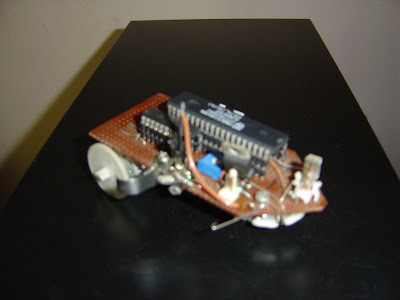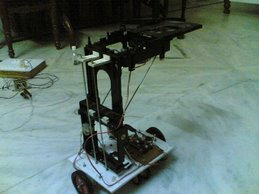STRUCTURE:::
This is basically a special pick and place mechanism. It is a prototype for any industrial transport operations. The machine in the picture below is a robot made out of CD tray. The mechanism of the CD tray has been directly used for the job. As seen one CD tray provides movement along one co-ordinate axes. So two trays are used to provide movement along two co-ordinate axes. One tray is placed on vertically and the other is place on this tray horizontally. So a combination of these two trays provide motion along two co-ordinate axes. This complete assembly is place on a four a vehicle which is a four wheel drive. The vehicle consists of four geared motors each having a torque of 2 Kgs. Each CD tray has a single motor that pushes or pulls the tray out or in respectively. The vertical tray holds the horizontal tray. So when the vertical tray gets a signal it is pulled up and hence the horizontal tray in closed position moves upward with it.
So the trays provide motion along two co-ordinate axes and the vehicle can move in the horizontal plane so combining the horizontal plane motion and the movement of the tray in upward direction we have motion along three co-ordinate axes. The motion along the co-ordinate axes can be controlled by the microprocessor based control system described below.
.jpg) Image 1 Both trays open
Image 1 Both trays open.jpg) Image 2
Image 2 CIRCUIT:::
The machine is completely autonomous and doesn't require any command externally. It is completely microprocessor controller system. Micro-controller 89C51RD2BN is used as the central processor of the machine. The motor drivers are L293D (Dual H-Bridge). The total number of motors in the machine are six. Four are used to drive the vehicle and the other two are used for the movement of the tray. All these six motors can be rotated in forward or reverse direction by giving appropriate signals to the drivers (L293D).
.jpg) Image 3 Both trays closed
Image 3 Both trays closed.jpg) Image 4.
Image 4.Watch Video:





.jpg)




